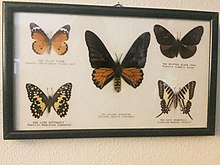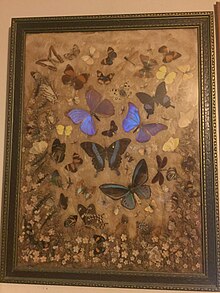This article has multiple issues. Please help improve it or discuss these issues on the talk page. (Learn how and when to remove these messages)
|
John August Kusche (1869–1934) was a botanist and entomologist who discovered species of moths and butterflies, and made extensive collections in remote South Pacific and Arctic regions, Alaska, Arizona, Hawaiian Islands, and elsewhere. He contributed many valuable specimens to collections at North American museums. A species of the aster family, Erigeron kuschei, was named after him.
Biography

August Kusche's father, Johann Karl Wilhelm Kusche, had four children: Herman, Ernst, Pauline and August, from his first marriage. Subsequently, after the divorce from his first wife, he remarried and had six more children: Bertha, Wilhelm, Heinrich, Reinhold, and two others who died at a young age. August’s father descended from a long line of farmers who tilled the lands around Kreuzburg, Germany.
Kusche attended a gardening school in Kreuzburg but left at a young age after unintentionally setting a forest on fire.
After the forest fire, he immigrated to America and corresponded with his family, encouraging them to join him.
His father relocated to Brownsville, Texas, shortly after February 1893 and established a homestead. After contracting yellow fever and recovering, his health was greatly affected, leaving him weak and unable to do much labor for money. He reached out to August, who was residing in Prescott, Arizona at the time, seeking financial assistance. August wrote back, saying "Dear father, if you are out of money, see to it that you go back to Germany as soon as possible. Without any money here, you are lost."
When August arrived in America, he got a job as a gardener on a Pennsylvanian farm. He had an affair with a Swiss woman named Louise Notz, and she became pregnant. August denied being the child's father, but was married to the woman soon after. He went west on horseback, but had his horse stolen by Native Americans. He ended up in San Francisco, and his family eventually joined him there. By this time, he had three sons and a daughter.

After his children grew up, he began traveling and collecting moths and butterflies.
Later life
He traveled to the islands of the Pacific Ocean, where he collected moths and butterflies. There, he caught a fever that nearly killed him. He was picked up by a government ship in New Guinea and was unconscious until he awoke in a hospital in San Francisco. He had hearing loss and lost all of his teeth. His doctor told him not to take any more trips to Alaska, which helped his condition.
In 1924, he lived in San Diego. He had taken a trip to Alaska just before this date. He worked as a gardener in California for nine years (1915–1924), where he died of stomach cancer.
Notable discoveries
In 1928, Kusche donated 164 species of Lepidoptera he collected on Kauai between 1919 and 1920 to the Bishop Museum. Of those species, 55 had not previously been recorded on Kauai and 6 were newly discovered, namely Agrotis stenospila, Euxoa charmocrita, Plusia violacea, Nesamiptis senicula, Nesamiptis proterortha, and Scotorythra crocorrhoa.
The Essig Museum of Entomology listed 26 species collected by Kusche from California, Arizona, Alaska, and the Solomon Islands.
References
- "California Plant Names". www.calflora.net. Retrieved 2024-07-02.
- Eastwood, Alice (1931). "New Species of Plants from Western North America". Proceedings of the California Academy of Sciences. Fourth Series. 20: 158. ISSN 0068-547X.
- ^ Memories of My Youth -Volume 1- , by Reinhold Kusche
- "List of Lepidoptera at the Bishop Museum, Collected by J. August Kusche on Kauai in 1919 and 1920" (PDF).
- "Bishop Museum - Taxonomy". www2.bishopmuseum.org. Retrieved 2017-02-18.
- "Essig Museum of Entomology Collections". essigdb.berkeley.edu. Retrieved 2017-02-18.